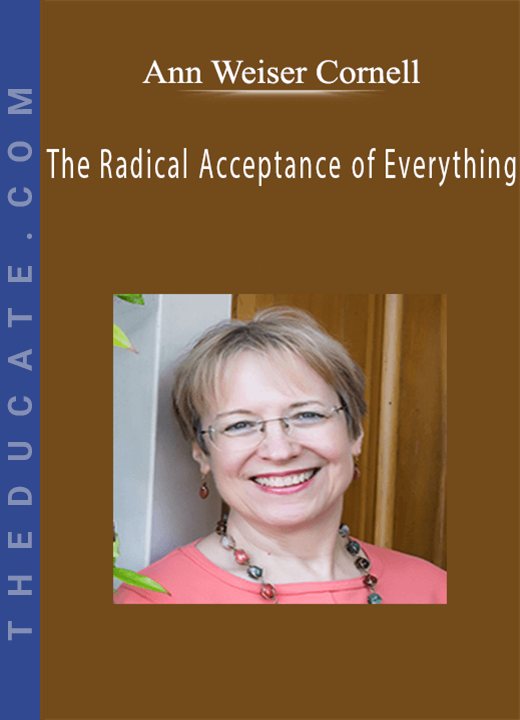Description

Ann Weiser Cornell – The Radical Acceptance of Everything
Description
This article originally appeared in the November 1994 issue of The Focusing Connection.
When we do Focusing as traditionally taught, it is as if we are inhabiting two worlds. In one world, we have absolute trust for the body and the body’s process. In the other world, we treat some experiences as acceptable, and others as unacceptable, needing to be set aside or excluded in order for the process to continue. In this second world the inner critic is treated as an interruption, as are thoughts. Felt senses may only come in the trunk area of the body, and chronic physical symptoms are not considered to be felt senses.
For the past several years I have been aware that my experience goes counter to this traditional teaching. For example, I have found that felt senses may come outside the “classic” Focusing area of throat, chest, belly. I have found that compassion for the critic may be more useful than setting the critic aside. But recently there has been a new synthesis in my practice of Focusing, both in myself and as a teacher. Many seemingly disparate threads have revealed themselves to be, really, one cloth. The name that I would give to this new understanding is “the radical acceptance of everything.”
What if we approach the teaching and practice of Focusing with a fresh and open mind? What if we let go of the various strategies and techniques we have been taught, and simply begin with three essential statements?
(1) Focusing is spending time with something that is not yet clear, something that has more to it than can be put into words at first.
(2) There is a bodily process that is more than the physical body as narrowly defined.
(3) The bodily process is trustworthy.
If you are someone who believes that Focusing can be defined by any number of steps (“Focusing is a ___ step process.”) or that Clearing a Space is a necessary part of every Focusing process, then you probably won’t be willing to follow me along this road. I propose we start by agreeing that there is an essence to Focusing that is beyond steps, and beyond any particular step, except perhaps the step of Being With What’s There.
So if we start with the essence of Focusing as captured in those three statements, and clear everything else away, what follows? Let’s see.
Felt Senses Outside the Trunk Area.
I was taught to guide a person’s awareness into the trunk — throat, chest, and belly — and if they felt something outside that area, to ask them to notice what they felt in the trunk about that. For example, “You might notice if you’re feeling something in your throat, chest, stomach area that goes with that ache in your jaw.” And of course there are other ways of phrasing this. But the traditional wisdom was either (1) felt senses come only in the trunk, or, more kindly, (2) felt senses may come elsewhere, but when felt in the trunk they communicate with the focuser more easily.
When Leonardo da Vinci was a boy, he was told that a nail placed in a tree would grow taller every year as the tree grew. Everyone knew that this was so. He tried it, and he found that it was not so; trees in fact grow from the top, and a nail placed at a certain height will never grow higher.
When I tried treated senses in the periphery of the body as if they were felt senses, both with myself and with others, they behaved like felt senses. They “made steps,” opened, revealed meaning, and attending to them eventually resulted in felt shifts.
If the bodily process is trustworthy, then perhaps it offers felt senses precisely in the area of the body where it most wants them to be felt. To make the sense move first, before it can be attended to, feels not respectful of the body’s wisdom.
Physical Symptoms as Felt Senses.
I was taught that physical symptoms cannot be felt senses, and that if a person had a physical symptom, they might be able to feel their feeling about having it, but that was the most that Focusing could do. Then I started hearing about people who didn’t follow “the rules” and who got amazing results from treating physical symptoms as felt senses. I published two of these accounts in this newsletter: Joe Tein’s “Focusing with Pain,” (The Focusing Connection September 1986) and Shirley Marten’s “And Then the Pain Went Away,” (The Focusing Connection September 1987).
Then in 1990 I had a chance to try this myself. It was the night before I was to start teaching a five-day workshop at the Omega Institute with Kevin McEvenue, and he had joined me to trade Focusing. I was depressed because I had a sore throat, a familiar symptom which always led to a cold, and I didn’t want to have a cold. I told this to Kevin and he, another non-rule follower, said cheerfully, “Let’s focus on it!” When treated as a felt sense, the sore throat yielded meaning, something about how I was putting pressure on myself to be an “expert.” By the next morning, the sore throat was gone, and I felt fine. No cold.
Last month in England I tried this again, on a cold that had already been going for twenty-four hours. There were four or five symptoms, and I picked the most prominent, the feeling of rawness in my lungs. After I had heard its inner meaning, having to do with having taken on someone else’s feelings, I had one of the most amazing experiences of my life — I felt the symptom leave my body in the space of about thirty seconds. Interestingly, the cold remained, with all the other symptoms continuing and running their course. I do wonder what would have happened if I’d had the time to focus on each one in turn!
However, I have found in my work with myself and clients that treating a physical symptom as a felt sense doesn’t always lead to an alleviation of the symptom, and that it doesn’t matter. I have one client who has a chronic condition of dry eyes. She often starts her sessions with awareness of her eyes, and receives meaning from that awareness. This is a rich area for her, even though the symptom has not yet changed. I’m convinced that even a broken leg would have a felt sense “quality” or “aspect” if attended to in this way, and would yield meaning, even though we wouldn’t expect the leg to knit instantly.
We seem to have an ingrained assumption that experiences are either physical or emotional, but not both. I believe this assumption arises from the tragic legacy of the mind-body split. If we see with fresh eyes, why couldn’t something be both physical and emotional? Why couldn’t it yield emotional meaning through Focusing, even though it has also been accurately physically diagnosed?
Thoughts and Other “Distractions.”
For many years, I treated thoughts as intrusions to the Focusing process. When a focuser would say to me, “My mind is coming in,” I would say, “Maybe you could thank your mind for its help and ask it to step aside for now.” If a focuser said, “I’m getting distracted,” I would say, “Maybe you could let that distraction go and come back to your body.”
But then a new and radical possibility began to come into my awareness. What if there are no distractions? What if each thing that comes is somehow a part of the process, and can be welcomed as such?
I watched a student guide working with a new person in a training seminar. The focuser reported that he felt nothing in his body. The student worked diligently to enable him to feel something. At one point the focuser reported, “Thoughts about my work are coming into my head.” In accordance with my teaching, the student asked the focuser to set those thoughts aside. But, watching the session, I was struck by the possibility that the thoughts might have been a part of the process. Perhaps the thoughts had been the body’s way of introducing content and meaning. I wondered what would have happened if the guide had said, “Maybe you could notice how you feel in your body about those thoughts about your work.”
Today when a focuser tells me they are distracted, my response is, “Maybe the distraction is relevant.” If it’s not, we’ll soon know. But let’s not throw it out before we check whether it might have been the body’s way of bringing the next piece.
Recently I was doing a first session in a workshop setting. Her felt sense was of a pressure on her abdomen, but it kept disappearing when she tried to stay with it. Finally she opened her eyes and looked at me.
“It isn’t working,” she said. “I keep getting distracted.”
“Maybe the distraction is relevant somehow,” I suggested.
“I don’t think so,” she said. “A black cat walked in and sat down.”
“OK,” I said. “Let’s let the black cat be here. Is it still here?”
She closed her eyes, checked, and nodded.
“So see if you can sense what mood it’s in.”
She sensed, then said, “It’s scared.”
“Oh, so let it know you hear that it’s scared. And then see if it might want to let you know what it’s scared about.”
“I get an image of my mother, and a choking in my throat. Guilt. I wish I could take care of my mother better.”
That was the key to the session, and when she acknowledged it, she felt relief and release.
After the session was over, the focuser told us that the black cat had been the one she’d had when she was a child, which had been killed.
An hour later, as we were about to end the session for lunch, a black cat walked into the circle as if it owned the place. We gasped — how did that happen? It was the final touch to a lovely session.
I’m left with renewed appreciation that anything which comes in a session is probably a part of the process, and nothing should be dismissed as a distraction until it is carefully resonated first.
The Critic.
And what would happen if we extend our radical acceptance of everything to Mr. Critic as well? What if we see the inner critic, not as an interruption, but as a natural part of the process?
I approached my recent series of workshops with this new possibility in mind, freshly inspired by Barbara McGavin’s article in the September 1994 Focusing Connection. Previously, I had taught a three-part approach to the critic. First, ask it gently to step aside, second, if that doesn’t work, ask it its positive purpose, and third, if nothing else works, ask the critic to move around in front of the focuser and have the focuser ask it, “What hurt you or worried you or scared you that you’d be talking to me like that?” It was a very elaborate set of techniques that sometimes took quite a long time.
When I began doing sessions at the Focusing Center of the Hague, I found myself treating the appearance of the inner critic in a much simpler, more organic way. When the focuser reported, “Now my critic is coming in,” I would say, “Ah, yes. And maybe you could notice if there’s some feeling or emotion, right there.”
It’s hard to describe how wildly successful this was! You would think that people would talk about the critic’s anger or contempt, or report the downtrodden felt sense of the criticized part. But what actually happened was not that at all. Over and over again, by feeling and reporting the emotion that came with the critic, the focuser went right back into the very heart of the Focusing process. “It’s grief,” one woman reported. “There’s so much fear there,” said a man. In each case, being with this emotional quality led into deep process. The critic was not an interruption, it was simply a way that part of the process chose to express itself.
So the radical acceptance of everything brings a new possibility of trust, a feeling of greater wholeness to the Focusing process. As guides we are no longer guardians of the gate, watching to allow in some experiences and exclude others. Instead, we are holders of the open space that includes whatever wants to come. We are not afraid of what comes in the focuser. We know that there are no enemies in the inner world. We enable the focuser to form a positive relationship with what comes, a relationship of listening and acceptance or, if that isn’t possible, a relationship with the part that finds it hard to accept what’s there. The spirit is one of inclusion, not exclusion. The attitude is one of welcome.
The radical acceptance of everything is consistent with the spirit of Focusing, and it works. Do try it yourself, and let me know how it goes.







9 reviews for Ann Weiser Cornell – The Radical Acceptance of Everything
There are no reviews yet.